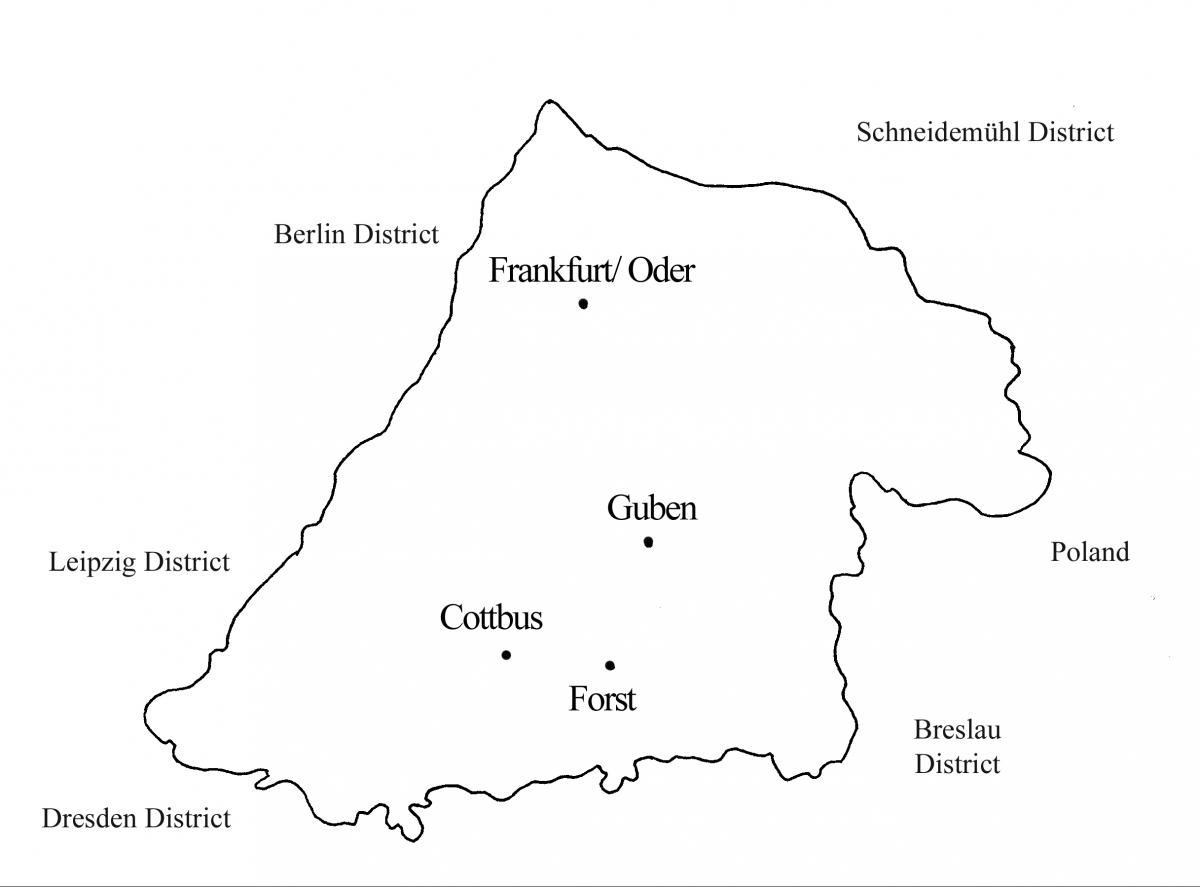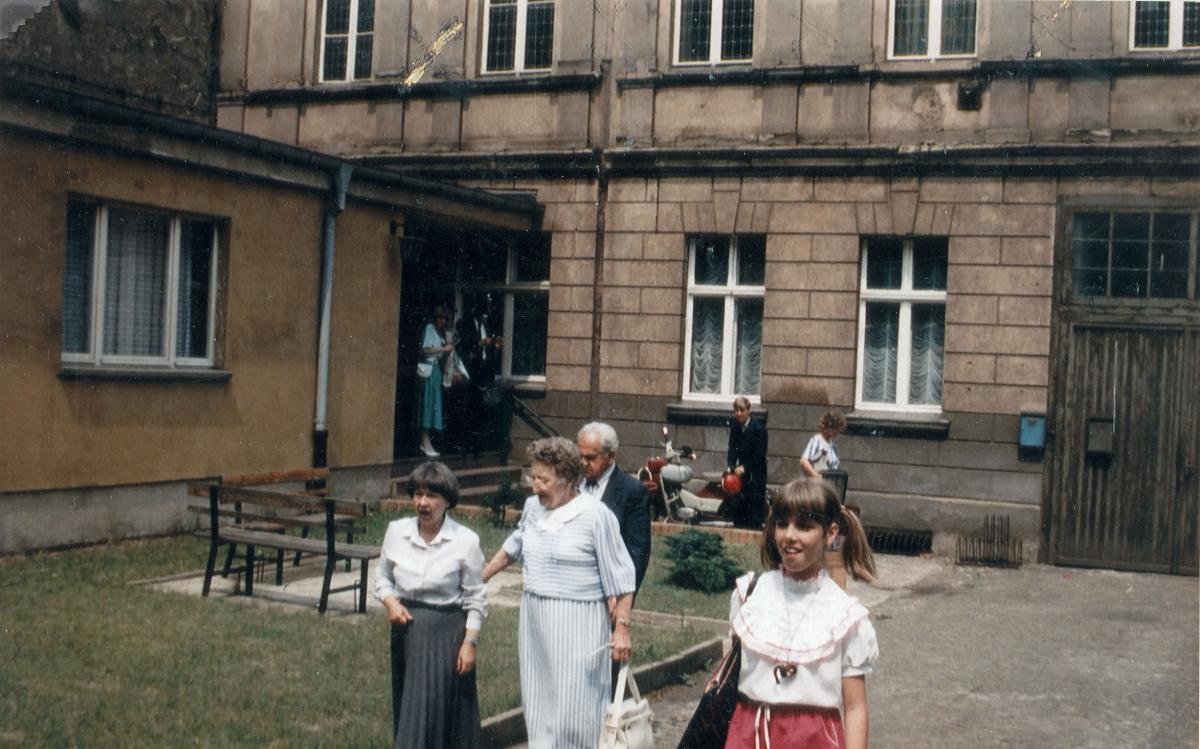Spreewald District
Roger P. Minert, In Harm’s Way: East German Latter-day Saints in World War II (Provo, UT: Religious Studies Center, Brigham Young University, 2009), 417-9.
The only district in the East German Mission not named for a city was the Spreewald District. The Spreewald (“the forest through which the Spree River flows”) is located roughly between the city of Berlin and the province of Silesia to the southeast. Only four cities comprised the district throughout World War II: Frankfurt on Oder (about sixty-five miles southeast of Berlin), Cottbus (ninety miles southeast of Berlin), Forst (fifteen miles east of Cottbus), and Guben (thirty-eight miles south of Frankfurt on Oder).
| Spreewald District[1] | 1939 | 1940 | 1941 | 1942 |
| Elders | 24 | 24 | ||
| Priests | 8 | 10 | ||
| Teachers | 7 | 7 | ||
| Deacons | 30 | 31 | ||
| Other Adult Males | 45 | 40 | ||
| Adult Females | 188 | 184 | ||
| Male Children | 28 | 29 | ||
| Female Children | 21 | 21 | ||
| Total | 351 | 346 | 347 | 344 |
The district included the southeast section of the historic province of Brandenburg. To the northwest was the Berlin District, to the northeast the Schneidemühl District, to the east Poland, to the southeast the Breslau District, and to the southwest the Dresden District.
The president of the Spreewald District throughout the war was Fritz Lehnig (born 1893) of Cottbus. According to eyewitness accounts, Brother Lehnig also functioned for at least part of the war era as the president of the Cottbus Branch.
 The Spreewald District had only four branches.
The Spreewald District had only four branches.
Little is written about this district in the history of the East German Mission. The following entry is found under the date May 18, 1938:
On this, the previous, and the following day, special meetings were held in Frankfurt an der Oder, Cottbus and Forst Branches, Spreewald District, by Elder Edward R. McKay, to discuss the new genealogy plan, which was presented at that time.[2]
As was the case all over the East German Mission, genealogical research was in full swing when the war started, and members were active in sending family data to the mission office in Berlin to be checked for completeness and accuracy. Approved data were forwarded to the LDS Genealogy Department in Salt Lake City.
The following entry is dated February 16, 1939:
Members and friends of the Spreewald District met in Cottbus to attend a special entertainment. A spirit of better cooperation and service was obtained. More than eighty percent of the district membership was present.[3]
The reason for a need of better cooperation is not mentioned, but the percentage of the membership in attendance on that occasion is impressive.
Doris Schäler (born 1933) recalled attending district conferences during the war:
Our branch loved to go to the regularly-scheduled Bezirkskonferenz, which was usually held in Cottbus. We met other members from different branches, such as Guben, were taught, and heard all the latest news, which usually included the most recent casualties of war.[4]
During the last year of the war, many Latter-day Saint refugees arrived in Cottbus at the home of Fritz Lehnig. At Lausitzerstrasse 53 he owned a small factory-like building, one floor of which had been used as a restaurant. The structure became a haven for Saints driven from their homes in districts to the east by the advancing Red Army. Brother Lehnig was a hero in the minds of many surviving eyewitnesses in that he was able to harbor many Saints on his property and find food for all of them and jobs for some. This was the case for more than a year after the war as well, until many of the refugees were forced by the city government to move out; they traveled farther west in search of new homes.
Brother Lehnig was a great proponent of priesthood power and insisted that a blessing on the sick was superior to the powers of physicians and surgeons.[5] Under his direction, each day in the refugee camp began with a hymn and a prayer, after which work assignments for the day were determined. Several eyewitnesses recalled that despite the privations of 1945 and 1946, they enjoyed the feeling of living in a “united order” where everybody shared what they had.
 The property owned by Fritz Lehnig in Cottbus as it appeared in recent years. The upper floor was the residence of more than one hundred Saints in 1945–46. (E. Grünewald Schulz)
The property owned by Fritz Lehnig in Cottbus as it appeared in recent years. The upper floor was the residence of more than one hundred Saints in 1945–46. (E. Grünewald Schulz)
Nevertheless, the cramped conditions caused predictable stress. Jutta Obst (born 1939) later recalled the conditions in the months after the war ended in May 1945: “The number of Saints now exceeded two hundred. For nine months we were packed like sardines in a can.” One evening, two young women decided that they could not tolerate the conditions and returned to their apartment. They were molested repeatedly that night by Red Army soldiers; in despair the following morning, they turned on the gas and ended their lives.[6]
In September 1945, Brother Lehnig was apparently required to submit to the city a list of persons residing under his roof. That list shows precisely 118 persons, some of whom had come from as far away as Königsberg, East Prussia, and Breslau, Silesia. The mayor’s office required a response within twenty-four hours regarding the official registration status of each person on the list. It is very possible that other Latter-day Saint refugees were living on the property at the time but had not yet been registered with the city.[7]
Due to the lack of bread in the Lehnig refugee camp, the ordinance of the sacrament included other types of food, principally potato peelings. According to Jutta Obst, “I’m sure the Lord was pleased to accept our offering, no matter what emblems were used, so long as they were blessed and partaken for the renewing of the sacred covenants.”[8]
In the summer of 1946, many members of the Church left the Lehnig property to seek new surroundings farther west (in the American or British occupation zones, if possible). Eventually, activity at the Lehnig property declined.
The parts of Brandenburg that lay east of the Neisse River were ceded to Poland following the war. That territory included suburbs of the cities of Guben and Forst. By the end of 1946, members of the Church living on the east side of the river in those towns were evicted from their homes and never returned.
By the end of World War II, all four branches were still officially in existence, but the Guben Branch had been decimated and ultimately did not survive.
Notes
[1] Presiding Bishopric, “Financial, Statistical, and Historical Reports of Wards, Stakes, and Missions, 1884–1955,” CR 4 12, 257.
[2] East German Mission Quarterly Reports, 1938, no. 22, East German Mission History.
[3] Ibid., 1939, no. 56.
[4] Doris Charlotte Schaller Shapardanis, “World War II Experiences of the Schaeler Family and Members of the Forst Branch” (unpublished), 3; private collection.
[5] Jutta Obst Burch, “Portrait of My Family” (unpublished family history, 2003), 9; private collection.
[6] Ibid.
[7] Mayor of the City of Cottbus to Fritz Lehnig, letter, September 28, 1945; private collection.
[8] Burch, “Portrait of My Family,” 11.
